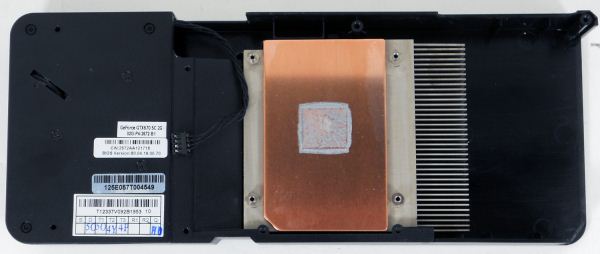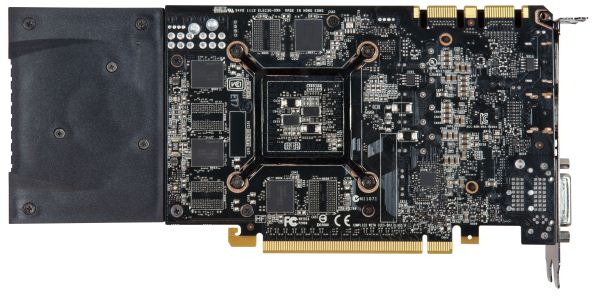NVIDIA GeForce GTX 670 Review Feat. EVGA: Bringing GK104 Down To $400
by Ryan Smith on May 10, 2012 9:00 AM ESTMeet The GeForce GTX 670
Because of the relatively low power consumption of GK104 relative to past high-end NVIDIA GPUs, NVIDIA has developed a penchant for small cards. While the GTX 680 was a rather standard 10” long, NVIDIA also managed to cram the GTX 690 into the same amount of space. Meanwhile the GTX 670 takes this to a whole new level.
We’ll start at the back as this is really where NVIDIA’s fascination with small size makes itself apparent. The complete card is 9.5” long, however the actual PCB is far shorter at only 6.75” long, 3.25” shorter than the GTX 680’s PCB. In fact it would be fair to say that rather than strapping a cooler onto a card, NVIDIA strapped a card onto a cooler. NVIDIA has certainly done short PCBs before – such as with one of the latest GTX 560 Ti designs – but never on a GTX x70 part before. But given the similarities between GK104 and GF114, this isn’t wholly surprising, if not to be expected.
In any case this odd pairing of a small PCB with a large cooler is no accident. With a TDP of only 170W NVIDIA doesn’t necessarily need a huge PCB, but because they wanted a blower for a cooler they needed a large cooler. The positioning of the GPU and various electronic components meant that the only place to put a blower fan was off of the PCB entirely, as the GK104 GPU is already fairly close to the rear of the card. Meanwhile the choice of a blower seems largely driven by the fact that this is an x70 card – NVIDIA did an excellent job with the GTX 560 Ti’s open air cooler, which was designed for the same 170W TDP, so the choice is effectively arbitrary from a technical standpoint (there’s no reason to believe $400 customers are any less likely to have a well-ventilated case than $250 buyers). Accordingly, it will be NVIDIA’s partners that will be stepping in with open air coolers of their own designs.
Starting as always at the top, as we previously mentioned the reference GTX 670 is outfitted with a 9.5” long fully shrouded blower. NVIDIA tells us that the GTX 670 uses the same fan as the GTX 680, and while they’re nearly identical in design, based on our noise tests they’re likely not identical. On that note unlike the GTX 680 the fan is no longer placed high to line up with the exhaust vent, so the GTX 670 is a bit more symmetrical in design than the GTX 680 was.

Note: We dissaembled the virtually identical EVGA card here instead
Lifting the cooler we can see that NVIDIA has gone with a fairly simple design here. The fan vents into a block-style aluminum heatsink with a copper baseplate, providing cooling for the GPU. Elsewhere we’ll see a moderately sized aluminum heatsink clamped down on top of the VRMs towards the front of the card. There is no cooling provided for the GDDR5 RAM.

Note: We dissaembled the virtually identical EVGA card here instead
As for the PCB, as we mentioned previously due to the lower TDP of the GTX 670 NVIDIA has been able to save some space. The VRM circuitry has been moved to the front of the card, leaving the GPU and the RAM towards the rear and allowing NVIDIA to simply omit a fair bit of PCB space. Of course with such small VRM circuitry the reference GTX 670 isn’t built for heavy overclocking – like the other GTX 600 cards NVIDIA isn’t even allowing overvolting on reference GTX 670 PCBs – so it will be up to partners with custom PCBs to enable that kind of functionality. Curiously only 4 of the 8 Hynix R0C GDDR5 RAM chips are on the front side of the PCB; the other 4 are on the rear. We typically only see rear-mounted RAM in cards with 16/24 chips, as 8/12 will easily fit on the same side.
Elsewhere at the top of the card we’ll find the PCIe power sockets and SLI connectors. Since NVIDIA isn’t scrambling to save space like they were with the GTX 680, the GTX 670’s PCIe power sockets are laid out in a traditional side-by-side manner. As for the SLI connectors, since this is a high-end GeForce card NVIDIA provides 2 connectors, allowing for the card to be used in 3-way SLI.
Finally at the front of the card NVIDIA is using the same I/O port configuration and bracket that we first saw with the GTX 680. This means 1 DL-DVI-D port, 1 DL-DVI-I port, 1 full size HDMI 1.4 port, and 1 full size DisplayPort 1.2. This also means the GTX 670 follows the same rules as the GTX 680 when it comes to being able to idle with multiple monitors.
















414 Comments
View All Comments
CeriseCogburn - Friday, May 11, 2012 - link
And let's add, since another amd fanboy has a big problem again - let's add, the great and "superior" amd Tahiti "gpu compute monster ! housefire !" gpu loses miserably in the compute benchmarks in this review, loses 3 tests to nVidia, to the gpu teh amd fanboys have spewed is very, very bad in compute compared to their loser amd 7970 core.Hey, how about that, now we both have some compute to talk about, and how amd is a loser failure, and nVidia won again, even in compute ! :)
Wow, I guess compute is really, really, really important like all the amd fanboys have been saying this entire thread.
CeriseCogburn - Friday, May 11, 2012 - link
Here's the idiot spew from you about compute on the prior page, amd fanboy: " Anyway, 7970 is a superior product over 680 if only for the compute performance it offers."LOL
It lost the benches here clueless.
ROFL
I love my amd fanboy friends.
versesuvius - Saturday, May 12, 2012 - link
Oh, you are back. Learned to read?Which benchmark are you talking about, know nothing imbecile? You are talking about this review? Are you trying to tell us that you cannot read or count? We already know that. Oh, you are trying to tell us that NVIDIA cannot get its act together even on the one benchmark that it has always done good, with 670 falling behind everyone? Hey, you are making progress. The NVIDIA way. Keep it up. You are doing fine.
CeriseCogburn - Sunday, May 13, 2012 - link
In this review nVidia won 3 compute benches and and won 2 compute benches.Nvidia 60%
amd 40%
Not like the very data here means anything to you.
Nfarce - Thursday, May 10, 2012 - link
One of my SLI 570s crapped out last month. Knowing the 670 was on the horizon but not willing to wait, I grabbed a 680 for $520 (EVGA Superclocked 2682 model - the only one that I could grab with F5 tapping). Looking at how close the 670 is to the 680, and (as of right now) looking at all the stock of 670s on Egg, I overspent by $100 when I could have had the Superclocked 670. I had no idea the performance was going to be that close.And who would have thought these things would actually be available? Kicking myself...kicking myself...
CeriseCogburn - Thursday, May 10, 2012 - link
At least you didn't spank out $579.99 plus tax and fees on the 7970 - which had a value drop off like rock from a cliff while official drivers were still absent.$130 plus tax and fees, crappy mismatched and total fail drivers, the usual strange and inexplicable crashing with ten fixes per incident any one of which may work "for a while" or with ones fingers crossed but you never know which one...
Yeah dude, I'm not feeling sorry for you.
Burticus - Thursday, May 10, 2012 - link
I like what I'm reading about the 670's performance and huge overclocking ability... but I'm sorry $400 is just too much for a video card for me. I am not the hardcore gamer I used to be, and sad to say I do a lot more on the console now than the PC. I mean when a card costs more than my car payment, that is just sad. For what? Bragging rights? 10 fps faster in Skyrim? Anything over 60 fps is pure gravy, people.Needs to get to $200 or less for this kid to get into the game. And I doubt 660 gets under that. I have a sneaky feeling they are going to make the 660 $299 and the 650 will be $199. Assuming a TI something doesn't pop up in the $250 range which probably will.
My "old" GTX 460 768mb can limp along for a few more months. Heh, that has been a good little card and it was only $150.
Nfarce - Thursday, May 10, 2012 - link
Well that's fine and dandy for you. But others have invested in 3 monitors and are running 5760x1080/1200 resolutions or one expensive one at a 2560x1440/1600. Older cards and especially sub-$400 cards just aren't going to run those kinds of resolutions with details up, which defeats the purpose of getting said monitors in the first place.PC gaming to play the latest and greatest maxed out never has been, nor will it ever be, cheap. I also am an avid console player (PS3). Dirt 3 and Crysis 2 on my PS3 and 55" LED looks like a PS2 game compared to it running DX11 on my PC with a 27" 2560x1440 LCD monitor and maxing out things with my 680.
SlyNine - Sunday, May 13, 2012 - link
I can get this 680GTX below 60FPS at 1080P. Op doesn't know what he's talking about.As far as console gaming. Its funny, you see screen shots and think that looks close. Than you actually play the games on both platforms and go, yea they look nothing alike.
dunce - Thursday, May 10, 2012 - link
I would like to see a 7970OC comparison? I was trying to find a 680 but gave up and got an 7970oc for $499 it's running at 1025Mhz and should be faster than a 680.